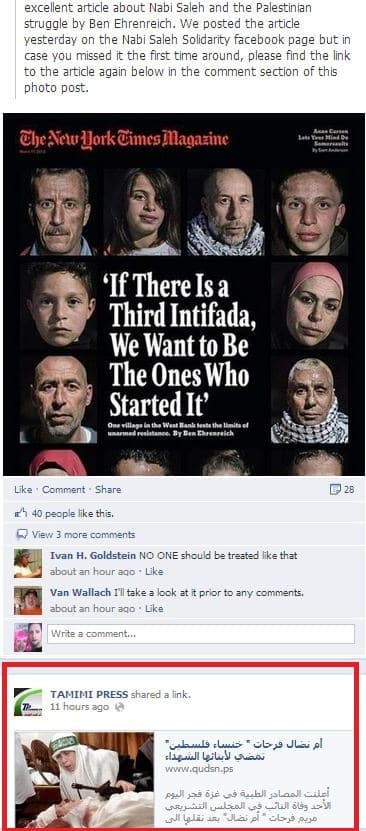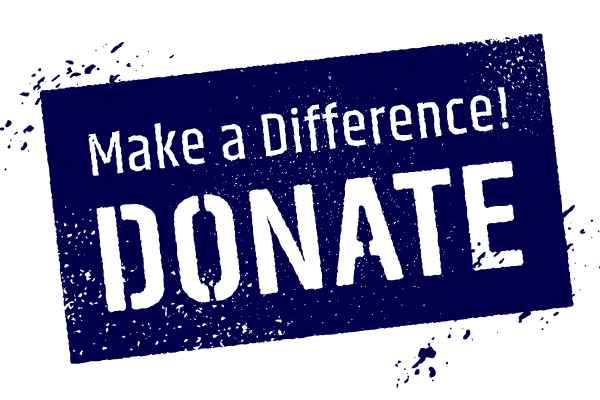Last night, I posted how I was mentioned in a NY Times article, albeit referred to simply (and derogatorily) as a “right-wing blogger”.
The article dealt with the inhabitants of the village of Nabi Saleh – home of Shirley Temper – and constitutes a real hatchet job on Israel.
The Roths – who lost their 15-year-old daughter Malki in the Sbarro suicide bombing of 2001 – have posted a powerful critique of this NY times hit piece.
Friends have pointed us to this week’s NYT Magazine cover story, published today. It’s devoted to a Palestinian Arab village set in the hills a few kilometers north of where we live in Jerusalem. It’s a place the author calls “spirited”, where “on warm summer evenings, life… could feel almost idyllic. Everyone knows everyone.” He says “a pilgrimage”to this magical place “has achieved a measure of cachet among young European activists, the way a stint with the Zapatistas did in Mexico in the 1990s”.
Who would not be captivated? But there is much wrong with the picture he conjures up. We know this because for years we have been tracking the media’s romance with the community called Nabi Saleh. I am furious with anger as I sit here writing about what the article says, and what it carefully avoids saying.The Wikipedia entry for Nabi Saleh describes the village of some 550 people in gentle terms. Centred on an old religious shrine to the prophet Shelah whom we encounter in Genesis as the son of Judah and grandson of the patriarch Jacob, it was a hamlet of a mere five houses in the late nineteenth century when the Turks ruled the area. It grew slowly under the Jordanian military occupation that started in 1948; then declined when Israel took control of the West Bank in 1967, and flourished and multiplied in the past two decades. Today, it’s the scene of weekly protest demonstrations and, to judge from Wikipedia’s English-language version, a place where things are done to passive inhabitants and for no apparent reason.Interestingly, if you go to the Arabic-language version of Wikipedia, it puts the emphasis elsewhere, describing Nabi Saleh as a place of “popular resistance” that took a prominent role from the outset in two Intifadas, providing “hundreds of prisoners” and 17 so-called “martyrs on the altar of freedom”. The most prominent of the prisoners (Wikipedia’s description) is a woman called Ahlam whose surname is shared with almost every other inhabitant of the village: Tamimi.But it’s Bassem Tamimi who is the focus of the article. He says the Intifada launched by Yasser Arafat in 2000 was “the big mistake… Politically, we went backward”. The writer helps us understand what kind of backward he means:“Much of the international good will gained over the previous decade was squandered. Taking up arms wasn’t, for Bassem, a moral error so much as a strategic one. He and everyone else I spoke with in the village insisted they had the right to armed resistance; they just don’t think it works. “
Or to say it another way: they are entitled to kill the Israelis and have done so again and again, but it’s not effective. A different kind of warfare therefore needs to be adopted.Half-way through the essay, he introduces readers to a figure who embodies that “big mistake”:In 1993, Bassem told me, his cousin Said Tamimi killed a settler near Ramallah. Eight years later, another villager, Ahlam Tamimi escorted a bomber to a Sbarro pizzeria in Jerusalem. Fifteen people were killed, eight of them minors. Ahlam, who now lives in exile in Jordan, and Said, who is in prison in Israel, remain much-loved in Nabi Saleh.
That’s all he writes about Ahlam Tamimi but we can tell you more. She is a Jordanian who was 21 years old and the news-reader on official Palestinian television when she signed on with Hamas to become a terrorist. She engineered, planned and helped execute a massacre in the center of Jerusalem on a hot summer afternoon in 2001. She chose the target, a restaurant filled with Jewish children. And she brought the bomb. The outcome (15 killed, a sixteenth still in a vegetative state today, 130 injured) was so uplifting to her that she has gone on camera again and again to say, smiling into the camera lens, how proud she is of what she did. She is entirely free of regret. A convicted felon and a mass-murderer convicted on multiple homicide charges, she has never denied the role she embraced and justifies it fully.Yet all the NY Times says about Nabi Saleh’s favourite one-time resident is that she was an escort “who now lives in exile in Jordan”. Period. This is no oversight. The editors at the New York Times showcased this psychopath once before, six years ago. Then, as now, we felt someone needed to push back, and we posted two blog articles: “7-Aug-07: Hot House: Cold Truths” and “28-Jun-07: About sweet-faced young women”, and got some attention. But it was clear to us that those who thought they perceived greatness of spirit in her continued to do so.One of the lives she snuffed out was that of our precious daughter Malki who was fifteen years old. Malki was the kind of young woman whose life and achievements ought to have entitled her to at least a fraction of the media coverage bestowed by the NYT editors and others on the murderer. But those editors, as well as the author of today’s Magazine piece, are evidently less affected by the innocent lives of the victims, lived and lost, than by the hypnotic power of symbolism.
About the lethal rock-hurling attacks directed at Israelis, Bassem Tamimi says
he didn’t worry over whether stone-throwing counted as violence. The question annoyed him… If the loincloth functioned as the sign of Gandhi’s resistance, of India’s nakedness in front of British colonial might, Bassem said, “Our sign is the stone.” The weekly clashes with the I.D.F. were hence in part symbolic. The stones were not just flinty yellow rocks, but symbols of defiance… The message they carried, he said, was “We don’t accept you.”
Stone-throwing as a symbol? People have been killed and (as recently as this past Thursday) critically injured by the rocks (and cement blocks and boulders) of the ‘stone’ throwers. Perhaps “we don’t accept you” is what people living far from the scene imagine goes through the minds of baby-killers and restaurant bombers. But living where we do, innocent-sounding turns of phrase like that leave us dumbfounded.Ahlam Tamimi’s post-massacre trajectory has been like something out of Hollywood – or perhaps the NYT Magazine. On conviction in October 2003, she was sentenced to 16 life terms in prison. The presiding judge, having heard her proudly claim credit for the killings and maimings, added for the record the view of the judicial panel that she “not be eligible for pardon by the military commander, nor to early parole by any other means”. He and his fellow judges (and my wife and I as well) were ignored when eight years later, almost to the day, she walked free as one of the 1,027 murderers and assorted other terrorists unjustly freed – not pardoned – as part of Israel’s agreement to the extortionate terms of the Gilad Shalit transaction.
She flew to Jordan the same day, was married there on live television to another freed and unpardoned murderer (a cousin, a Tamimi from Nabi Saleh), addressed rallies in various Middle East capitals, and became a media hero as the presenter of a weekly Hamas satellite television program. This is devoted to the interests of imprisoned Palestinian Arab terrorists, and broadcast from Amman to all corners of the Arabic-speaking world. Latest reports say she is preparing for the arrival of a baby. How the twists and turns of this life have impacted on her victims has never, as far as we know, been explored by any branch of the media, presumably for reasons of lack of interest. But within the Arab world, she is a celebrity.
Bassem Tamimi receives a salary from the foreign-aid-funded Palestinian Authority. But, like many thousands of other Palestinian Arabs on the massively-bloated PA payroll, he admits to the NYT Magazine that he almost never has to report to his office or do any work (while blaming this on the Israelis). The article might have pointed out, but did not, that massive servings of no-strings-attached funds paid by European governments to the terrorism-friendly PA are the reason men like Bassem Tamimi have the time and energy it takes to become a star of the New York Times and a source of videos, interviews and opinions.His own photogenic daughter has achieved fame and influence and even been awarded a prize by one of the Middle East’s more Israel-phobic political figures for playing her part. Photos of her sticking a fist in the face of IDF servicemen in Nabi Saleh, the personification of an innocent sort of juvenile courage, are everywhere. (The NYT article mentions that she has been dubbed “Shirley Temper” in some quarters; you can see why in this video clip.) In reality, those images of defiance were captured by a horde of press agency photographers arranged by her parents. They followed the girl around as she walked up to one Israeli officer after another, hoping to provoke a camera-worthy (meaning violent) response. It never came, though not for lack of effort.
She has been used in this way again and again by her parents and community; there is no shortage of collaborators among the paparazzi. Any connection between this contrived set-piece and reality is entirely accidental.
Read the entire thing.
I will add the following: As I posted recently with regards to a Ha’aretz puff piece on Bassem Tamimi, his Tamimi Press Facebook page clearly indicates he is fighting for a one-state solution – a palestinian state – and supports terrorism and the terrorists who perpetrate heinous killings in support of this very goal.
Case in point: Right below where Tamimi proudly posted a link to the NY times article on his Facebook page is a link to an obituary of recently deceased Hamashole and terrorist matriarch Umm Nidal.
The question is what kind of journalist is Ben Ehrenreich…dishonest or sloppy?




